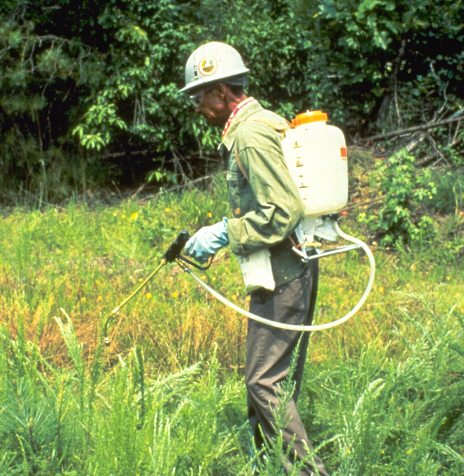IRVM Herbicide Application History
Table of Contents

In the early days of IRVM, many counties sent crews into ditches equipped with backpack sprayers to carefully spot-spray weeds. While this method provided good weed control with a minimal amount of herbicide, roadside managers soon learned they could not cover enough of the county since it takes a lot of time to manage weeds on foot.
Since then, IRVM has helped drive the development of spray truck technology that delivers herbicides with the accuracy and control needed to live up to the program’s original principles—killing target species without weakening non-target species or putting too many chemicals in the ground. Progress has been made, not just with more responsive on/off control switches and multi-directional spray nozzles, but also with systems that monitor flow, record data, and significantly reduce operator exposure. As with any spraying equipment, the technology is only as good as the person whose finger is on the trigger. The objective is still to spot spray. Beware of getting comfortable and sitting too long in the cab, which can make you drowsy and more likely to miss problem weeds. Be conscientious, stay alert, and be ready to grab the handheld sprayer and walk to that distant shrub to treat it properly. Never underestimate the value of handheld labor; sometimes, it is still best to put on the old backpack.
Roadside Real Talk
Insights from Roadside Managers and Other Professionals
We don’t spray shoulders, just bridge abutments and guardrails. We don’t spray wild parsnip unless asked or if there’s a really rank patch. Unfortunately, if we tried to spray every parsnip plant, we’d essentially be blanket-spraying many areas.
—Jim Uthe and James Devig, Dallas County, 2024
I publicize in the paper when we will start spraying and encourage people to call me with locations of sensitive areas—gardens, bee hives, people who have allergies, etcetera. I have “No Spray Zone” signs for willing landowners.
—Jeff Chase, Des Moines County, 2024
High-diversity roadsides are more robust and more resistant to weeds. Maintain high diversity even if you don’t have the opportunity to establish natives. Don’t spray species that are not creating problems. Our goal each season is to cover half the county for noxious weeds and the other half for brush. Most of the weed spraying is noxious thistles and teasel. When spraying brush, we try to cover areas in which brush and trees were cut the prior winter to catch any regrowth.
We have isolated patches of garlic mustard that get sprayed. However, what exists in the ditch is usually spillover from the woods. What makes it to the ROW is just the tip of the iceberg, so I don’t get too excited about chasing it down. We have plenty of parsnip that, historically, were sprayed every year. Still have plenty of it. We currently do not spray parsnip.
—Wes Gibbs, Jones County, 2024
I feel like addressing the spraying of noxious weeds was one way we built some goodwill as we have aggressively attacked those during the peak months of June and July.
—Sean O’Neill, Sac County, 2024
I mostly use the web or my sales rep for technical support. It’s too hard to maintain up-to-date, written information on the most effective herbicides for each species. But like anything else, the advice is only as good as the source.
—Josh Brandt, Cerro Gordo County, 2009


